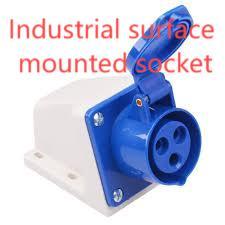In many facilities, specifying the right Industrial surface mounted socket early in the design process reduces retrofit costs and improves operator safety on the shop floor. During layout planning, teams often place a well-chosen Industrial surface mounted socket where equipment access, cable management, and maintenance frequency demand quick, protected power points.
Why Surface-Mounting Is Often the Best Choice
Surface-mounted outlets remove the need to cut recesses into finished walls or machine guards, which is particularly useful in retrofit or temporary installations. They permit fast replacement, easier inspection, and simpler access during routine maintenance. For facilities with dynamic layouts or frequent reconfiguration, surface-mounted outlets minimize disruption and speed project timelines.
Materials, Sealing and Environmental Ratings
When selecting an enclosure, prioritize robust plastics or GRP (glass-reinforced polyester) for corrosive or wet environments, and consider stainless steel for abrasive or chemically aggressive sites. Match the ingress protection (IP) rating to the worst-case exposure — IP66/67 for heavy washdowns, or IP54 for dry indoor areas — and verify gasket compounds and fastener finishes for chemical compatibility in your plant atmosphere.
Electrical Performance, Safety and Standards
Confirm that the chosen unit’s current and voltage ratings exceed normal operational loads and possible inrush currents. Verify contact metallurgy and plating (silver or silver-alloy contacts are common) for duty-cycle longevity. Compliance with IEC, UL, or regional standards simplifies approvals; for critical circuits, consider integrated earth-fault or mechanical interlocks to prevent accidental disconnects under load.
Vendor Ecosystem and Accessory Options (Featuring Schneider Electric)
An established vendor ecosystem reduces integration risk. Brands such as Schneider Electric offer accessory kits — gland plates, mounting brackets, DIN-rail adaptors, and spare contact modules — which accelerate installation and simplify spare-parts management. When selecting equipment, check accessory compatibility, documentation quality, and the supplier’s spare-part lead times to avoid production delays.
Installation Techniques That Preserve Ratings
Best practice is to mount onto flat, prepared surfaces with recommended torque for captive fasteners to avoid housing distortion. Orient cable entries so condensate or ingress drains away from critical connections. Use appropriately sized cable glands and strain relief to prevent mechanical loads on terminals, and label each outlet clearly with circuit identification and rated voltage to assist safe lockout/tagout procedures.
Inspection, Maintenance and Lifecycle Planning
Regular inspections extend service life. Check gaskets, fastener torque, and cover latches periodically; measure contact resistance if overheating is suspected. Maintain a small stock of critical spares such as gaskets, fasteners, and contact modules to shorten repair time. Document installed models and accessory part numbers to support future upgrades and replacement cycles rather than emergency, reactive fixes.
Practical Applications Across Sectors
Manufacturing lines use surface-mounted outlets for local tool power and test stands. Outdoor event distribution and temporary site power benefit from weatherproof models. Food processing and washdown environments require sanitary-friendly housings with high IP ratings, while logistics hubs rely on ruggedized connectors for vehicle charging and maintenance bays where accessibility and durability are paramount.
Specifier Checklist and Final Considerations
-
Determine the maximum environmental exposure and choose an appropriate IP rating.
-
Specify electrical ratings with margin for inrush and fault currents.
-
Select housing materials compatible with the site atmosphere.
-
Confirm accessory availability and vendor support.
-
Plan maintenance intervals and spare-part stocking to reduce downtime.
Conclusion
Surface-mounted sockets may appear small, but they play a large role in safe, maintainable electrical distribution. Thoughtful selection of rated enclosures, compatible accessories, and robust installation practices reduces downtime and protects personnel and equipment. For product specifications, modular accessory options, and ordering information, visit www.nante.com/product/



